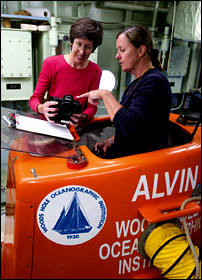
|
 |
Research > Ocean
Institutes > Deep Ocean Exploration Institute
Deep Ocean Exploration Institute
 |
 |
|
Director Susan Humphris (right) with Senior Research Assistant Margaret Sulanowska. (Photo by Tom Kleindinst) |
The Deep Ocean Exploration Institute (DOEI) investigates processes that shape the planet’s surface, regulate the chemistry of its oceans, and impact its inhabitants. In the past two decades, interest has escalated in microorganisms that may live in the crust and sediments of the ocean. In fall 2003, national and international experts came to WHOI for a seminar series on the deep biosphere. At the same time, two new DOEI fellows initiated research on an emerging theme in DOEI called Earth’s Deep Biosphere.
Wolfgang Bach, a geochemist, is studying the relationship
between geochemical and microbiological processes occurring within oceanic rocks to see if organisms
are altering the newly generated crust at mid-ocean ridges. Greg Hirth, a geophysicist, is using his understanding of the physical properties of rocks to investigate interactions between cracking in the oceanic
crust and biogeochemical processes. In addition, Olivier Rouxel, a new postdoctoral fellow, began research
that uses isotopes as tracers of the existence of a deep biosphere in the oceanic crust.
Five new research projects were funded within DOEI’s ongoing theme of Seafloor Observatory Science and Instrumentation and the theme of Fluid Flow in Geologic Systems. Dan Frye, an engineer, along with John Collins, a geophysicist, will develop data capsules that pop up periodically from the ocean floor instrumentation, float to the surface, and send their data via satellite to scientists on shore. Biologists Tim Shank and Stefan Sievert will investigate how the chemical and microbial environment at seafloor hydrothermal
vents might act as settlement cues for larvae
during their initial colonization. Geophysicist Jeff McGuire will deploy newly developed instruments to measure movement across a transform fault often associated
with earthquakes and seafloor spreading.
Other researchers funded by DOEI plan to study larval dispersal of organisms at hydrothermal vents, while others will adapt an instrument that measures concentrations of many elements simultaneously for use at vent sites.
The Institute hosted two workshops in 2003. “The Next Generation of In Situ Biological and Chemical Sensors in the Ocean” was co-sponsored with the WHOI Ocean Life Institute, the National Science Foundation, and the Office of Naval Research, for participants from academia and industry. Engineers and scientists at WHOI also participated in the workshop “Mapping and Visualization Techniques,” conducted by the Center for Coastal and Ocean Mapping at the University of New Hampshire.
In May, DOEI joined with the WHOI Ocean and Climate Change Institute,
as well as scientists from the California Institute of Technology,
to present a special online Dive and Discover expedition dedicated
to climate change. Scientists diving in the submersible Alvin
at the New England Seamounts, a chain of undersea volcanoes
about 500 miles from North America, collected deep-sea corals
that reveal variations in ocean chemistry over time. These changes
may indicate how Earth’s climate rapidly cooled or warmed in
the past, and provide clues to how climate may change in the
future.
—Susan Humphris (shumphris@whoi.edu)
Deep Ocean Exploration Institute Director
|
|
